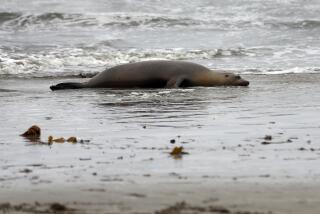7.6 Million Fish Die in a Day at Salton Sea
SALTON CITY — As predictably as swallows return to Capistrano in the springtime, fish die at the Salton Sea in August.
But this year, almost 8 million fish died in a single day last week, the largest one-day death toll ever recorded in these troubled waters. And that is renewing the controversy over the future of California’s largest lake.
Residents contend that despite the numbers, the Aug. 4 death of about 7.6 million tilapia is just another fish die-off--as much a part of the Salton Sea as summer heat and southwest winds.
Some scientists, however, say the die-off is yet another omen of the sea’s demise, and they warn that the end may be approaching faster than expected.
“Is the end coming quicker? It would appear so,” said Barry Costa-Pierce, director of Mississippi-Alabama Sea Grant College, who conducts numerous studies at the sea sponsored by the federal government. “The Salton Sea is dying. Our response plan needs to be rapid, or I give it a couple of years before we have massive die-offs year-round. This is just the beginning.”
Since the fish died Aug. 4, the number of endangered brown pelicans found with avian botulism has increased to about 35 per day, said Clark Bloom, manager of the Sonny Bono Salton Sea National Refuge. Pelicans eat only live fish, raising the question of how the birds’ illness is linked to the fish deaths.
“The number of sick and dying birds is escalating on a daily basis, and to me a 7.6-million-fish die-off is significant--that’s a huge bunch of fish,” Bloom said. “There’s a reason this is happening and I don’t think it’s been explained yet. This magnitude took us by surprise.”
Milt Friend, lead scientist in a federal evaluation of the Salton Sea, acknowledged that “for years it was business as usual after fish and birds died, but now they’re dying in greater frequency and the magnitude of this loss is alarming. This is an ecosystem in rapidly failing health.”
In the largest single-day die-off before last week, 500,000 fish died last summer, Bloom said. Residents contend that there were large die-offs in the 1980s, with dead fish covering an area the size of two soccer fields, but they did not occur in a single day. Also in the 1980s, deformities were found in brown pelicans and initially attributed to the pesticide DDT, a link that scientists still argue about.
Twice as large as Lake Tahoe, the Salton Sea was created by a 1905 engineering mistake that sent a torrent of Colorado River water pouring into a salt sink. Long publicized and politicized as an ecosystem in failing health, the sea has no natural drainage and is a sump for agricultural runoff. The fish were stocked in the 1950s to promote tourism.
The accepted scientific explanation of summer fish die-offs involves the oxygen-depleting combination of sun and salt. Salt water carries less oxygen than fresh water; hot water carries less oxygen than cool water. When the sea’s increasingly briny water heats up in summer temperatures that can reach 125 degrees, fish begin to suffocate.
When a summer wind churns up the nutrients, algae blooms, sometimes turning an entire end of the lake green within a day. The decaying algae also consumes more of the water’s oxygen.
All of which leads to stretches of shore lined with dead fish. This time, the blanket of dead fish along the north side of the lake was 10 miles long and three miles wide. Almost all the dead fish were the fast-growing, rapidly reproducing tilapia. The corvina favored by fisherman were spared.
Residents are unimpressed. “It’s just something that happens, has always happened, is to be as expected as summer heat in the desert,” said Norm Niver, a member of the Salton Sea Citizens Advisory Panel, who lives at the sea’s edge. “They keep saying this is unprecedented. But we’ve been here over 20 years and every time that water churns up in the summer, we have dead fish, just as many or more as this time. You have to live here, you have to really see it, to understand.”
Niver and his wife, Connie, fish in the lake from their frontyard dock just about every day. They boat. They swim. Norm Niver, a tanned and hardy 69-year-old who favors Hawaiian print shirts, has been known to dip a glass in the sea (though not during a fish die-off) and drink the water just to prove a point.
“I’m tired of the bad hype scaring people away. Fish die this time of year. Every time it gets hot in Palm Springs, do scientists show up asking why? The whole world knows the sea has problems. Why keep hammering it?”
Steve Horvitz, superintendent of the Salton Sea Recreation Area, agrees. On a day this week, when rotting fish were still washing ashore, flies were thick and the recreation area’s parking lot sat empty, Horvitz appeared to have one of the tougher jobs in California--enticing people to come enjoy the Salton Sea.
The sea remains a certified Class I recreational body of water--safe for fishing, swimming and boating.
Horvitz, who questions the estimate of 7.6 million dead fish, said he is afraid the problems of the Salton Sea have been overemphasized in relation to the recreational opportunities it still offers. “I’ve had congressmen tell me, ‘Don’t say it’s not all bad. We have to say it’s a disaster to save it,’ ” he said. “But I think if you present nothing but the problems, people give up.
“We need people to come here and enjoy themselves so they care what happens to the sea,” he said.
After the sea’s environmental problems were publicized, the number of visitors dropped to a low of 87,000 in 1994, Horvitz said. Last year, 250,000 people visited, a far cry from the glory days of the early 1960s, when the sea was promoted as the next Mediterranean and rangers couldn’t take money from campers fast enough to avoid back-ups on the highway.
In May, the sea received surprising good news when a federally funded study found that it and its fish had not been contaminated by pesticides from agricultural runoff, a revelation that fostered hope that cleaning up the sea may not be impossible, as once feared.
But every possible solution dreamed up by scientists to save the sea with pumps and dikes and canals has a price tag in the hundreds of millions of dollars. Some argue that the sea should be allowed to follow a natural course from lake to wetlands to dry land.
But if the sea is allowed to reach the point where fish can no longer survive, it will affect millions of migratory birds on the route between the Pacific Northwest and the Gulf of California, some argue. It also will not bode well for pricey golf course real estate in Coachella Valley cities within sniffing distance of rotting fish.
Last year, a $380-million cleanup bill was passed by the House of Representatives, but was reduced to a $5-million study by the Senate. By Jan. 1, the Salton Sea Authority, an agency created to save the sea, must report to Congress on the lake’s health and how it can be saved. But the question now is whether the latest die-off signals that the sea is setting its own deadline.
“We need to act immediately, or we fail, and I think that means we’re a failure as a society,” Costa-Pierce said.
But on this day the sea was the color of tea, the greenish tint of the die-off about gone. People were already out fishing.
Connie Nivers conducted her own fish study by dipping an empty margarine bucket in the water and scooping up dozens of baby tilapia. “There’s so many billions of fish in this sea that when you step in it feels like a massage with them nibbling on you,” she said. “Don’t tell me this lake is dying.”
More to Read
Sign up for Essential California
The most important California stories and recommendations in your inbox every morning.
You may occasionally receive promotional content from the Los Angeles Times.











